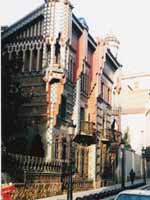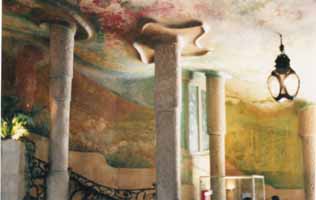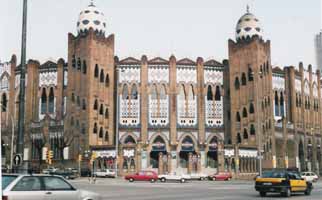 |
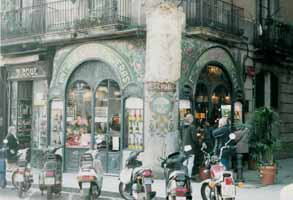 |
 |
| The Bull Ring | 19th century café on La Rambla | Ancient streets the size of sidewalks |
That is largely the fault of one Antoni Gaudi, a turn of the century architect who designed and erected almost a dozen structures here. They are easily the wildest and most complex I have seen. They are colorful, intense and simple at the same time, and most are screaming landmarks. Inspiring doesn't begin to describe viewing one of these. A quick description - Casa Mila is dedicated to the sea: balconies are decorated with iron seaweed, staircases are waving surfaces of sand along the bottom, and green sea above. The ceiling of the (inevitable) bank is a rolling sea. The exterior walls are ageless, sea-worn-smooth surfaces of stone. The roof - the unbelievable roof - undulates in waves, permeated by outcroppings of "coral" and sea snakes or worms.
The Sagrada Familia is an unfinished (and unfinishable) cathedral of gigantic proportions. Thirty story spires representing the apostles rocket out of the base, seeming to converge on the center tower (unbuilt) representing God. It takes a very long time for the eye to absorb it all. The cathedral is a mass of styles, from the gothic to the starkly modern. And with his typical humor, Gaudi has turtles carrying weight of two of the spires - mythological, preChristian turtles.
Gaudi was a back of the envelope kind of architect. He had no problem incorporating workers' suggestions, and gave them a free hand in setting crushed tiles, for example, in whatever pattern they felt. There are no plans for the Sagrada Familia. Gaudi worked from his head. No mathematics involved. His spires were modeled in twine and tiny burlap sacs filled with buckshot. By hanging the structure upside down, he could see in a floor mirror what the spire would look like, and from the weights, know where the stresses were.
Stunning.
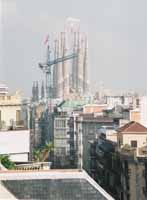 |
 |
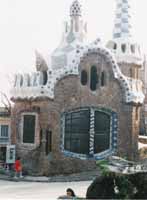 |
| Sagrada Familia - Day | Sagrada Familia - Night | Parc Guell - Icing on Cookie House |
But the whole city is a pleasure to see. The Art Nouveau style shops, the curving, narrow streets, barely big enough for pedestrians, let alone a car, resplendent with plants and laundry hanging from every balcony (Dryers are not a hot [sorry] item here). You just want to look upwards everywhere you walk. Of course this is not advisable, as the sidewalks are decorated, shall we say, excrementally. There is not a lot of green space in Barcelona, squeezed between the mountains and the sea as it is. The other reason you want to walk carefully is that the crush of pedestrians is armed and dangerous. Unlike other societies, Spaniards don't cup their cigarettes, and they smoke - a lot. They hold them pointing outwards so pedestrian beware. They love American cigarettes - brands you haven't seen in years (Luckies) and wannabe brands that pretend to have American lineage (Gold Coast). This may be why people here are into clothes so much - between the burns and the smell, they just don't last. Fashion? Flared pants, checks, and platform shoes are In in a very big way.
The boulevards are tree lined with grand old trees. The buildings, for their part, are festooned with tv antennas. Cable remains a concept, though DBS dishes can be seen here and there. The transit services are European excellent, and buses are equipped with electronic screens telling you the time, temperature, next stop, and of course, ads from sponsors. The subway is fast, clean and quiet (!), and not far below ground. They pipe in Muzak ("I worry that the man who thought up Muzak is thinking up something else" - Lilly Tomlin), and you can hear it clearly. That's how quiet it is.
The work "ethic" of Barcelona is only slightly more frenetic than the rest of Spain - that is to say, minimal. Unemployment is well over 20% in Spain, and half that here, which is not exactly cause for dancing in the streets. The phrase "going the extra mile" doesn't translate easily into Spanish or Catalan. The pace can be seen in the streets: outside of the major boulevards, all the intersections are diamond shaped. This forces you walk two sides of the diamond in order to cross the street and continue in a straight line. Hurrying is pointless. Coffee breaks run 45 minutes. Lunch runs from two to five, and everything but the restaurants close down to accommodate it. Lunch is the big meal of the day. It is always two plates, plus dessert. Even in the fast food restaurants you have your choice of wine or water - same price. Sunday everything is closed all day. Period. You couldn't shop Saturday? Starve.
 |
 |
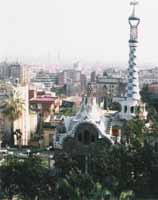 |
| Gaudi Rooftop | Sagrada Familia from Casa Mila | City View From Parc Guell |
The shops are almost all tiny affairs run by one person - usually a woman. The restaurants seem to be run largely by men. There is so little to do in these shops, the clerks are forever cleaning - dusting shelves, wiping glass, cleaning grout between tiles - you have to wonder how they ever make money. Perhaps that's not the object. I am new in town.
Food seems to be what life is all about. The restaurants and the bakeries, the markets and the butchers are all a sensual pleasure. I have had a hard time sampling all the kinds of pastries available here. I keep discovering new ones. But even the restaurants are never packed. A lot has to do with the season - not exactly a crush of tourists in the dead of winter - and possibly the 1992 Olympics, for which Barcelona had (like every Olympic venue) to overbuild.
If you somehow tire of the food, you can always drive to France. We did this one day. It took an hour and a half, largely because speed limits are a serving suggestion only. Perpignan is a delightful city with an extraordinarily active central area. It was wall to wall people, shopping - on a Thursday. I brought back a bagful of French pastries and breads, purely for scientific comparison, of course.
The language, Catalan, is a delightful mixture of French and Spanish. So, what with my decent French, my broken Italian, and my smattering of ignorance in Spanish, I could understand what everyone was saying. Reading? A snap. Speaking was a little more dicey, but with shopkeepers, a few key words is all you need. I leaned toward the French to make myself understood.
Despite the tiny, twisting streets in Barcelona, you can't get lost. Barcelona descends gracefully to the Mediterranean, so you can tell which way you have to go wherever you find yourself by seeing which way the street rises. It is not as culturally active as I would have expected given its three million base, but you can see all the films of Europe and the U.S. here. And between the Picasso Museum and the Dali Museum ("The largest surreal object in the world") they are well along the culture curve.
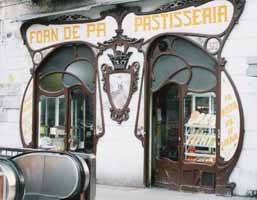 |
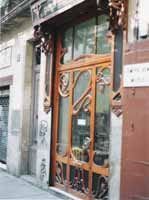 |
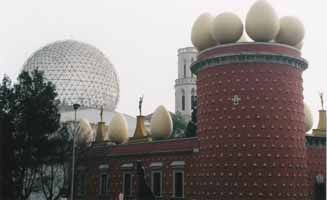 |
| Art Nouveau Bakery | Art Nouveau Bookstore | Dali Museum |
The old churches, surprisingly, are nothing to write home about, and aren't the center of musical offerings they are in a New York or a Paris. And everyone lives in apartments. The apartments in town are elegant, but small. The apartment blocks outside the downtown area look like Beijing or the Bronx. Not real pretty.
As long as we're being dreary, the air in Barcelona is disgusting. Unleaded gas is not mandatory, and you can usually see the air you breathe, feel it, taste it, and smell it. Incredibly, the prevailing westerly winds blow the pollution away - out to sea. It is frightening to imagine what it would be like if it didn't have those winds. Buildings are grimy, and throats get sore.
Back on the ecstatic side, the Palau de la Musica is a hall beyond belief. This must be the thing the word fantastic was coined for. Barcelona's other great architect, Lluis Domenech i Montaner, outdid himself in this intensely busy, outrageously colorful and complex music hall. Just one example: not satisfied with a merely gorgeous and intricate ceramic mosaic wrapping along the back of the stage, Montaner's figures come out in 3D relief - and life size, from the bust, up. It's as if they are entering our world through a magic mirror. And if it were not enough that it is the most visually stunning theater in creation, it also has acoustics that can only be described as phenomenal. Just go see anything that's playing there. It really doesn't matter. The real star is the building, and whoever is playing is going to sound the best they ever have. This place is a total experience.

